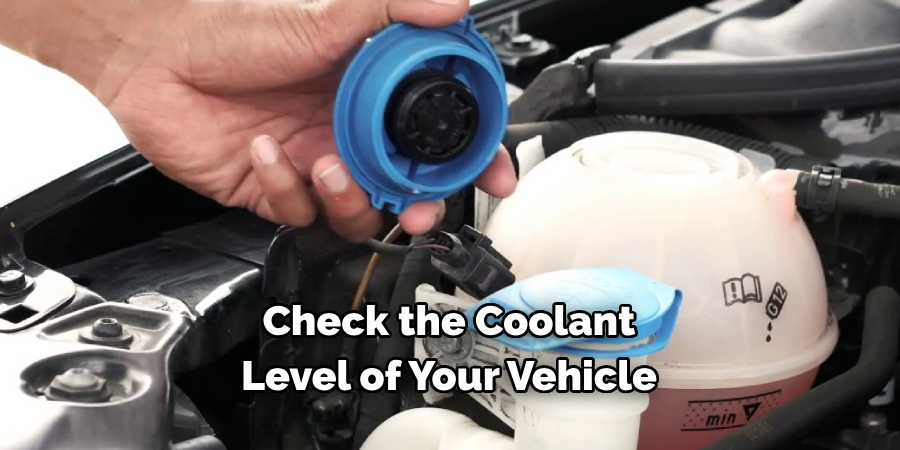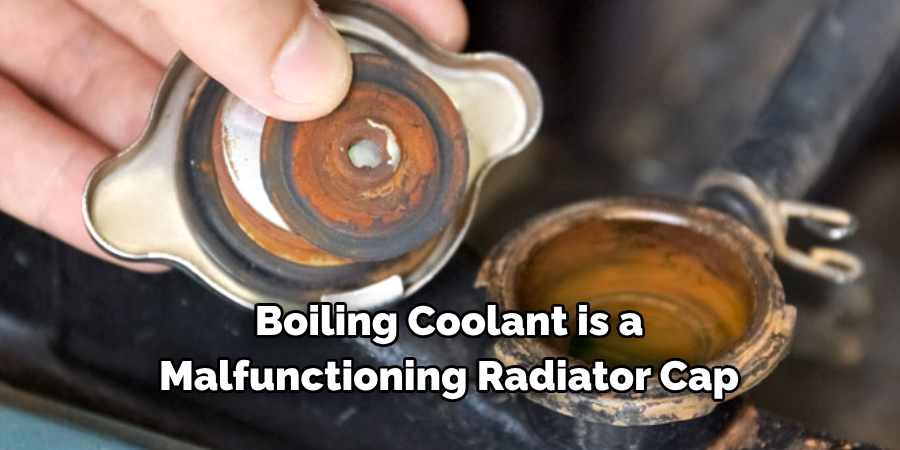Boiling coolant is a common problem that can lead to engine damage if not kept in check. Coolant boiling over can happen for several reasons, such as a low-pressure cooling system or an inadequate radiator cap. If left untreated, boiling coolant can cause permanent damage to your vehicle’s engine components and require expensive repairs.
One of the main advantages of fixing boiling coolant is that it can help prolong your engine’s life. This means that any repairs or maintenance you need will be much less frequent and expensive. Additionally, by ensuring that your engine stays cool, you can increase its efficiency and performance. In this blog post, You will learn how to fix boiling coolant.

Step by Step Processes for How to Fix Boiling Coolant
Step 1: Inspect the Coolant Level
Check the coolant level of your vehicle. If it’s too low, add more to bring it back up to the manufacturer-recommended amount. This could be causing the boiling problem. You should also inspect the radiator cap for any signs of damage or leakage. The cap is designed to keep the pressure inside the radiator, which helps prevent boiling. If it’s damaged or leaking, then replace it.
Step 2: Inspect Hoses and Clamps
The hoses and clamps should also be inspected for any signs of damage or wear. It should be replaced if the hose is soft, brittle, cracked, swollen, or pinched. The same goes for any clamps that are loose or rusted. The water pump pushes the coolant through your vehicle’s engine system, so ensure it’s in good condition. Look for signs of leaks and replace them if necessary. You can also spin the pulley shaft to ensure it’s turning freely.

Step 3: Inspect the Thermostat
The thermostat is responsible for regulating the temperature of your vehicle’s engine. If it’s stuck open, then it can cause the coolant to overheat and boil. You should inspect it for any signs of damage or wear and replace it if necessary. The radiator fan helps to keep your vehicle’s engine cool. If it’s not working correctly, then it can also contribute to boiling coolant. Ensure the fan is spinning freely and check the wiring for any signs of wear or damage.
Step 4: Check the Coolant Mixture
Depending on your vehicle type, your coolant may need to be diluted with water. Check the owner’s manual of your car and verify that it has the right mixture ratio. If not, then add more distilled water until it does. The heater core is responsible for circulating hot air into your vehicle’s cabin. If the core is clogged or damaged, it can contribute to boiling coolant. Try running a heater core flush to see if that helps.
Step 5: Flush Cooling System
Over time, rust and debris can build up in your vehicle’s cooling system, leading to boiling issues. To fix this, you should periodically flush your cooling system and replace the coolant with fresh fluid. Finally, make sure to monitor your vehicle’s temperature gauge. If it starts climbing higher than normal, that could indicate a boiling issue. Before continuing, stop the vehicle and inspect for any signs of leakage or damage.

Following these steps, you should be able to fix any boiling coolant issues with your vehicle. Be sure to consult an experienced car mechanic if you’re having persistent problems or unsure how to inspect and replace any components properly.
Precautions for How to Fix Boiling Coolant
- Ensure the engine is off and cool before beginning any repair work.
- Wear protective gear such as safety glasses, gloves, and long-sleeved clothing when performing the repair.
- Carefully inspect the radiator for any damage or corrosion, and replace it if necessary.
- Check all hoses connected to the radiator for any cracks, leaks, or loose connections.
- Clean and flush the cooling system to remove debris, rust, or dirt causing blockages.
- Ensure that the coolant level is properly filled and topped off as needed to prevent overheating.
- Test drive your vehicle after completing repairs to make sure that the coolant is no longer boiling. If not, further inspection may be necessary.
Following these precautions can successfully fix a boiling coolant issue in your vehicle. It is important always to take caution when performing repair work on your car’s cooling system, as it contains hazardous chemicals and requires specific steps for proper maintenance and repair.
What Causes Boiling Coolant?
The most common cause of boiling coolant is a malfunctioning radiator cap. The job of the radiator cap is to maintain the pressure in the cooling system and prevent fluid from boiling over at high temperatures. If the cap is not working properly, it can allow too much pressure to build up, causing the coolant to boil over. Other causes of boiling coolant include a faulty thermostat, low coolant levels, or a malfunctioning water pump.

To fix the boiling coolant, the first step is to check the radiator cap. When hot, a correctly functioning cap should hold pressure at or above 13-14 PSI. If the cap is not working properly, it must be replaced with an OEM part from the dealer or an aftermarket equivalent. Next, check the thermostat to make sure it’s working properly. A faulty thermostat can cause the coolant to overheat and boil over. If the thermostat is malfunctioning, it should be replaced with an OEM part from a dealer or an aftermarket equivalent.
How Can You Inspect Your Cooling System for Any Issues?
Once you have identified that your coolant is boiling, the next step is to inspect your cooling system for any possible issues. It’s important to check the components and connections of the radiator system, such as clamps, hoses, thermostats, water pumps, radiator fan motors, and radiator cap. Poorly secured clamps could be causing a leak, or the hose could be loose, allowing air to enter.
The thermostat and water pump might malfunction, while a faulty radiator fan motor could affect the engine’s cooling. You should also check for any signs of rust, corrosion, or debris in the system, which could clog up components and reduce coolant flow. If you’re unsure what to look for, it’s best to take your car to a certified mechanic who can check the system and offer professional advice on repairing any issues.
What Should You Do if Your Radiator is Damaged or Clogged?
If your radiator is damaged or clogged, it could cause the coolant to boil over. This can be a dangerous situation that needs to be addressed as soon as possible. If you find yourself in this situation, here are some tips on what to do:
- Immediately turn off the engine and allow it to cool down. Never open a hot radiator, as this could cause severe burns.
- Check the engine for any leaks and repair them immediately, if possible. If you cannot do so yourself, take your vehicle to a qualified mechanic to have it fixed.
- Once the coolant is at a safe temperature, open the radiator cap and check the antifreeze levels. If the levels are low, top them up with a 50/50 mix of antifreeze and water.
- Check the radiator for any blockages or damage causing the coolant to boil. If there is an obstruction, remove it and replace any damaged parts as necessary.
- Once all repairs and maintenance have been completed, start the engine and let it run for a few minutes. If the coolant is boiling over again, shut off the engine and re-check all repairs before restarting the vehicle.

Following these steps should help you to successfully fix any issues with your radiator that might be causing your coolant to boil over. It is important to take the necessary precautions to ensure the safety of yourself and others.
Is There Any Way to Prevent Boiling Coolant in the Future?
Yes, you can do a few things to help prevent problems with boiling coolant in the future. First, ensure your cooling system is full of fresh antifreeze and that all its components, such as hoses and clamps, are in good condition. Additionally, check the engine for any potential air leaks that could cause the cooling system’s over-pressurization.
Finally, keep an eye on the temperature gauge while driving–if it starts to rise rapidly, pull over and find out what’s wrong ASAP. Take your time! By being aware of and preventing the problem, you can avoid the hassle and expense of fixing boiling coolant.
How Often Should You Inspect Your Cooling System to Make Sure Everything is Working Properly?
Inspecting the cooling system should be a regular part of your routine when it comes to maintaining your vehicle. Regular inspections will help you identify any issues or problems with the coolant that could lead to the boiling coolant. This includes checking for leaks, corrosion, and damage to hoses and other components. Additionally, inspect all clamps and seals for signs of wear or damage. It is also important to regularly check the coolant level and condition.

The coolant should be changed every 1-2 years, depending on the type of vehicle and its usage. Ensure the coolant has the correct color and consistency according to your owner’s manual. If there are any signs of contamination in the form of rust, dirt, or debris, this could indicate an issue with the cooling system. Finally, check the coolant pressure regularly and ensure it is within the manufacturer’s specifications. If the pressure is too low, it could lead to boiling coolant, which can cause major damage to your vehicle’s engine.
Conclusion
In conclusion, fixing boiling coolant can be done with a few simple steps. First, you must identify the source of the problem and determine whether it is due to improper cooling system maintenance or a mechanical issue. It is important to ensure all components are in good working order before attempting to fix the problem. Once you have determined the cause, you should flush out any built-up contaminants or debris and replace worn-out parts.
After completing these steps, you should be able to restore your vehicle’s cooling system’s performance and prevent further overheating. Proper maintenance and care will ensure that your vehicle runs smoothly for a long time. This article has been beneficial for learning how to fix boiling coolant. Make Sure the preventive measures are followed chronologically.
